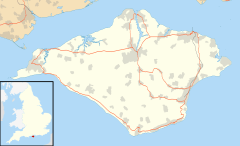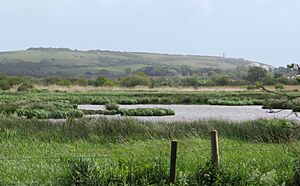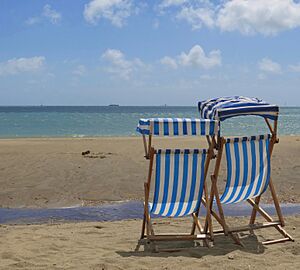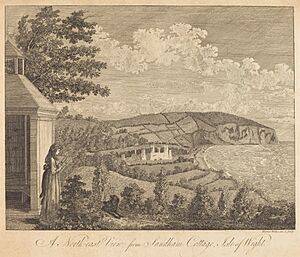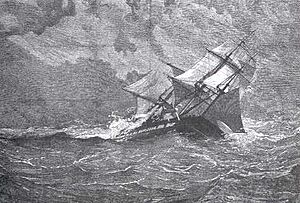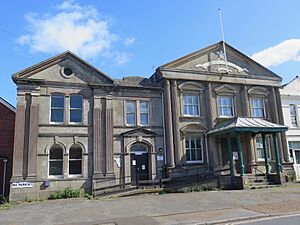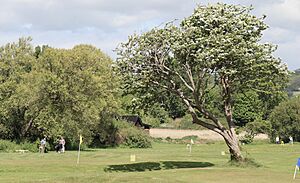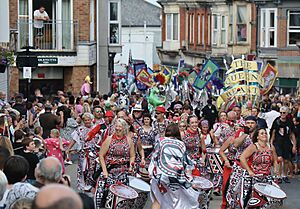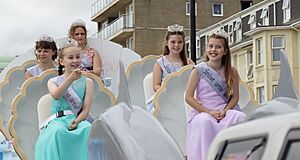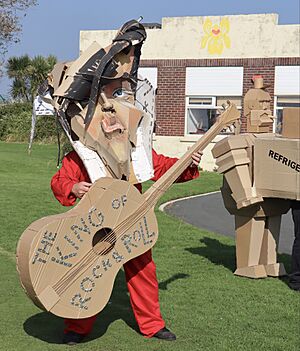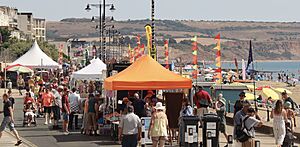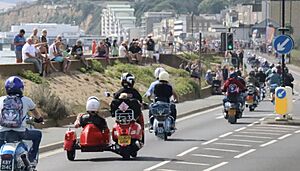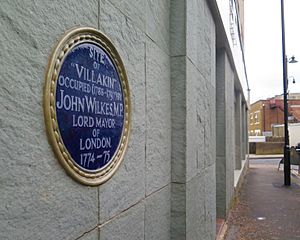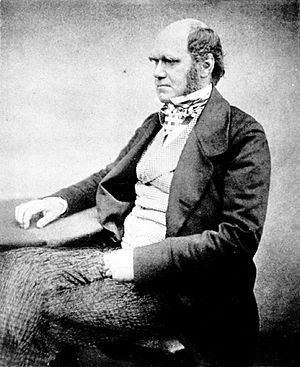Sandown facts for kids
Quick facts for kids Sandown |
|
|---|---|
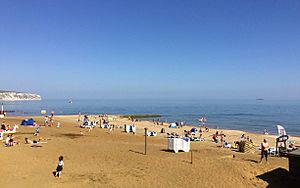 One of Sandown's sandy beaches |
|
| Population | 11,654 (2021 Census) |
| OS grid reference | SZ600843 |
| Unitary authority | |
| Ceremonial county | |
| Region | |
| Country | England |
| Sovereign state | United Kingdom |
| Post town | SANDOWN |
| Postcode district | PO36 |
| Dialling code | 01983 |
| Police | Hampshire |
| Fire | Isle of Wight |
| Ambulance | Isle of Wight |
| EU Parliament | South East England |
| UK Parliament |
|
Sandown is a fun seaside resort town on the south-east coast of the Isle of Wight, England. It's known for its beautiful sandy beaches. The towns of Shanklin and Lake are very close by, just to the south. Sandown has about 11,654 people living there, based on the 2021 Census. When you add Shanklin and Lake, the whole area has around 25,000 residents. Sandown is at the northern end of Sandown Bay, offering easy access to its long, sandy shoreline. The beaches stretch all the way from the cliffs at Battery Gardens in the south to Yaverland in the north.
Contents
Exploring Sandown's Nature
Sandown grew into a popular holiday spot during the Victorian era (the time when Queen Victoria ruled). It's surrounded by lots of cool natural places.
The coast and inland areas of Sandown are part of the Isle of Wight Biosphere Reserve. This is a special area recognized by UNESCO (a United Nations group) in 2019 for its unique nature and how people live alongside it. Sandown's seafront and clifftops are also part of the Isle of Wight Coastal Path, a great walking trail.
Sandown Bay, which gives the town its name, has five miles of sandy beaches. These beaches stretch from Shanklin all the way to Culver Down. This makes Sandown Bay home to one of the longest unbroken beaches in the British Isles!
To the north-east of town, you'll find Culver Down. This is a chalk hill that's open to everyone. Most of it is looked after by the National Trust. You can see typical chalk hill wildlife here, and even seabirds and birds of prey nesting on the cliffs.
Near Sandown, there are also the Sandown Levels. These are wetlands along the River Yar, one of the few freshwater wetlands on the Isle of Wight. Alverstone Mead Local Nature Reserve is a great place for birdwatching. At Sandown Meadows Nature Reserve, which was bought by a wildlife trust in 2012, you might spot kingfishers and water voles. If you go further inland, Borthwood Copse offers lovely woodland walks, with lots of bluebells in the Spring.
The sea area near Sandown, including its reefs and seabed, is a "Special Area of Conservation." This means it's protected because of its important marine life. If you visit at very low tide, you might even see a petrified (turned to stone) forest in the northern part of the Bay! Pieces of petrified wood often wash up on the beach.
Sandown's Past
People lived in the Sandown area even before the Romans arrived. During the Roman times, salt was made here.
Before the 1800s, Sandown was mostly known for its military importance. People worried that the Bay's beaches would be easy landing spots for invaders.
The town was once home to the Sandown Castle. This castle was being built in 1545 when French invaders attacked the Isle of Wight. They fought their way over Culver Down but were pushed back. The castle was built too close to the sea and was damaged by erosion. It was taken down less than a hundred years after it was built. In 1631, a new fort called Sandham Fort was built further inland. This fort was also taken down in the mid-1800s, and now Sandham Gardens is in its place.
In the 1860s, five new forts called Palmerston Forts were built along Sandown Bay. One of these, Granite Fort at Yaverland, is now the Wildheart Animal Sanctuary. On the western cliffs of Sandown, you can still see Sandown Barrack Battery, which is a protected historical site. Bembridge Fort, where the National Trust offers tours, can be seen on the hills to the north-east.
One of the first buildings in Sandown that wasn't for the military was Sandham Cottage. This was a holiday home for a politician named John Wilkes in the late 1700s. You can read more about him below!
When the railway arrived in 1864, Sandown started to grow a lot. The town's safe beaches became very popular for swimming. In the summer of 1874, the Crown Prince and Princess of Germany and their children rented several houses in Sandown and swam in the Bay often. Sandown's pier was built around the same time, opening in 1878, and was made longer in 1895.
Sandown became even more fashionable when the Ocean Hotel opened in 1899. This grand hotel was built around an older hotel. For its opening, many important people came from London by special boat. Guests explored Sandown in coaches, and the hotel staff wore uniforms like admirals!
In the 1900s, Sandown became a favorite holiday spot for everyone. The Canoe Lake opened in 1929, and Brown's Golf Course opened in 1932. The Art Deco Grand Hotel, which opened in 1938, is now closed.
Today, Sandown's seafront has a mix of old Victorian and Edwardian hotels, along with newer ones. They all look out over the beach and the Bay. A new Premier Inn hotel opened in 2021. Sandown Pier has an amusement center with arcade games, play areas for kids, and places to eat. The old part of the pier is now used for sea fishing.
Further north, you'll find the Wildheart Animal Sanctuary, which used to be the Isle of Wight Zoo. It started as Sandown Zoo in the 1950s. Today, it specializes in rescued tigers, other big cats, and monkeys. Nearby is the Dinosaur Isle palaeontology center, which opened in 2001. Sandham Gardens offers a dinosaur miniature golf course, other attractions for kids, and bowls.
The HMS Eurydice Disaster
On March 24, 1878, a Royal Navy training ship called HMS Eurydice (1843) sank in Sandown Bay. This was a terrible accident, and 317 lives were lost. It was one of Britain's worst naval disasters during peacetime. Even two months later, the tops of the ship's sunken masts could still be seen from Sandown. This was on the same day the town's pier opened!
The HMS Eurydice was brought back to the surface in August. It was then pulled onto the beach at Yaverland to be emptied of water. Queen Victoria herself came from Osborne House with her family to see the wreck.
There is a special memorial to the crew of the Eurydice in the graveyard of Christ Church, Sandown.
Sandown Town Hall
The Sandown Town Hall was built in 1869 and is a Grade II listed building, meaning it's historically important. It's located on Grafton Street. In 2021, plans were approved to change the building into homes. Inside, paint samples found evidence of a beautiful multi-colored ceiling decoration from 1873, which is now hidden under newer paint.
Brown's Golf Course
Brown's Golf Course was designed by a famous golfer named Henry Cotton. The idea for the pitch and putt courses came from Alex Kennedy, a pie and sausage maker from London. It opened on Sandown's eastern seafront in March 1932. The original clubhouse had the motto "Golf for Everybody" on its roof. During the 1940s, Brown's and its ice cream factory were reportedly used to hide equipment for "PLUTO" (Pipe Line Under The Ocean). This was a secret project to deliver oil to the D-Day beaches during World War II. The golf courses are still popular with people of all ages today!
Fun Events
Summer Carnival
Sandown has had a summer carnival since 1889! Today, the organizers put on many events, including a Children's Carnival and an Illuminated Carnival (with lights!). There's also the Sandown Bay Regatta and New Year's Day Celebrations with fireworks.
Hullabaloo
Since 2017, another fun event called Hullabaloo has been held in Sandown over a May weekend. It's organized by a carnival club with help from schools, musicians, businesses, and charities. The next Hullabaloo will be in May 2024.
Bay Regatta
Isle of Wight Scooter Rally
Sandown is one of the main places for this yearly event. It happens over the August Bank Holiday weekend and brings thousands of scooter riders from all over the UK and other countries. There's a special base for scooter riders with entertainment and camping at Sandown Airport.
Places to Visit
Sandown has many restaurants, cafes, bars, and pubs along the seafront and in the town.
Boojum and Snark is a unique place that opened in 2019. It was inspired by the author Lewis Carroll, who stayed nearby in the 1870s. It's the town's first eco-friendly microbrewery, offering craft beers and ciders, and also hosts art exhibitions.
Getting Around
Sandown railway station is a stop on the Island Line. This is the Isle of Wight's only public railway line, running from Ryde Pier Head to Shanklin. Trains are run by South Western Railway.
Sandown also has buses run by Southern Vectis. These buses can take you to places like Bembridge, Newport, Ryde, Shanklin, and Ventnor. There are even night buses on Fridays and Saturdays.
Sandown in Movies and TV
The UK music group Take That filmed the video for their song "I Found Heaven" on Sandown's beaches and seafront in 1992.
Sandown High School and nearby locations were used in the 1972 film "That'll Be The Day," which starred David Essex and Ringo Starr.
The TV series "Tiger Island," shown in 2007 and 2008, showed the lives of the more than twenty tigers living at the Isle of Wight Zoo.
Sandown was also featured in the Channel 5 TV series "Isle of Wight: Jewel of the South," which aired in the UK in 2023 and 2024.
Sister Towns
Sandown used to be twinned with the town of Tonnay-Charente in France. It was also twinned with St. Pete Beach, Florida in the United States.
Places Named After Sandown
The town of Sandown and its Bay have inspired the names of several places around the world! These include Sandown, New Hampshire in the USA, Sandown, Gauteng in South Africa, and Sandown Bay in South Africa's Western Cape. There was also an industrial area called Sandown in Australia, which had a railway line named after it.
Even ships have been named Sandown! The HMS Sandown, launched in 1988, was the first ship in a class of mine-hunting vessels. An earlier ship, the PS Sandown, was a paddle steamer that also served as a minesweeper during wartime.
Famous People from Sandown
- John Wilkes, a famous politician, often stayed in Sandown in the late 1700s at a place he called 'Villakin'. A plaque marks where his cottage was.
- The famous naturalist Charles Darwin worked on his very important book, On the Origin of Species, while staying at Sandown's King's Head Hotel in July 1858. He also visited the Isle of Wight at other times.
- The writer George Eliot (whose real name was Mary Ann Evans) stayed in Sandown in June 1863. She had recently published her novels Romola and Silas Marner.
- Frederick III, German Emperor and his wife Victoria, Princess Royal (who was Queen Victoria's daughter!) stayed in Sandown with their children for two months in the summer of 1874. Queen Victoria visited them. The German royals later gave a beautiful stained glass window to Christ Church, Sandown to remember their stay.
- The author Lewis Carroll, who wrote Alice in Wonderland, spent several summers on Sandown seafront in the 1870s. He was writing The Hunting of the Snark when he met 9-year-old Gertrude Chataway whose family was staying next door. His book is dedicated to Gertrude!
- The composer Richard Strauss (1864-1949) spent summer holidays at Sandown's Ocean Hotel in 1902 and 1903. He worked on some of his music while he was there.
- Sir Isaac Pitman worked on his system of shorthand (a fast way of writing) in Sandown in the 1860s.
- Many famous performers like Cilla Black, Frankie Howerd, and Tommy Cooper performed at Sandown Pier Pavilion in the late 1900s.
- Oscar-winning film director Anthony Minghella went to Sandown High School. Members of the music groups Level 42 and the Bees also went to Sandown High School and started their music careers in Sandown.
- Edward Upward (1903-2009), a long-lived author, lived in Sandown from 1961 to 2004.
- Mary Ellis, a pilot during World War II, later managed Sandown Airport. She passed away in 2018 at 101 years old!
See also
 In Spanish: Sandown para niños
In Spanish: Sandown para niños


